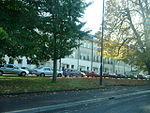King Edward's School, Bath
King Edward's School (KES), Bath, Somerset, England is an independent co-educational day school providing education for 1,016 pupils aged 3 to 18. The school is a member of The Headmasters' and Headmistresses' Conference. The school was established in the 16th century in a city centre site, founded in 1552. In the 1960s it moved to the outskirts onto a multi building site. In addition to the academic curriculum the schools includes drama, music, sport and a combined cadet force. King Edward's School Bath was judged as "excellent" in every category in the school's 2015 Independent Schools Inspectorate (ISI) report. The report noted that "The school's extra-curricular provision is outstanding", "Achievements outside the curriculum are both numerous and outstanding" and "The quality of the pupils' achievements and learning is excellent". The school was ranked as one of the top four independent schools in the south west by The Sunday Times Schools Guide, Parent Power Survey based upon 2016 academic results.
Excerpt from the Wikipedia article King Edward's School, Bath (License: CC BY-SA 3.0, Authors).King Edward's School, Bath
North Road, Bath Bathwick
Geographical coordinates (GPS) Address Website External links Nearby Places Show on map
Geographical coordinates (GPS)
| Latitude | Longitude |
|---|---|
| N 51.3863 ° | E -2.3436 ° |
Address
King Edward's School
North Road
BA2 6HU Bath, Bathwick
England, United Kingdom
Open on Google Maps










